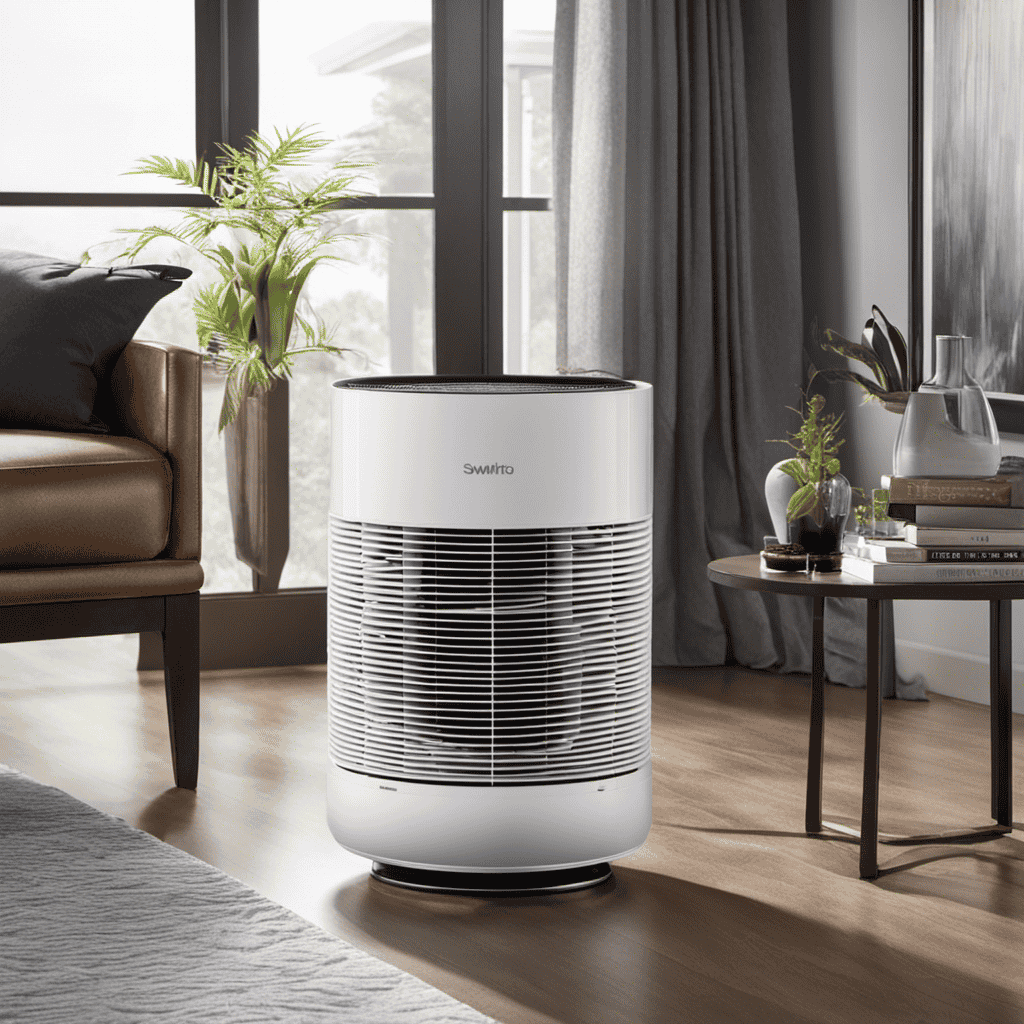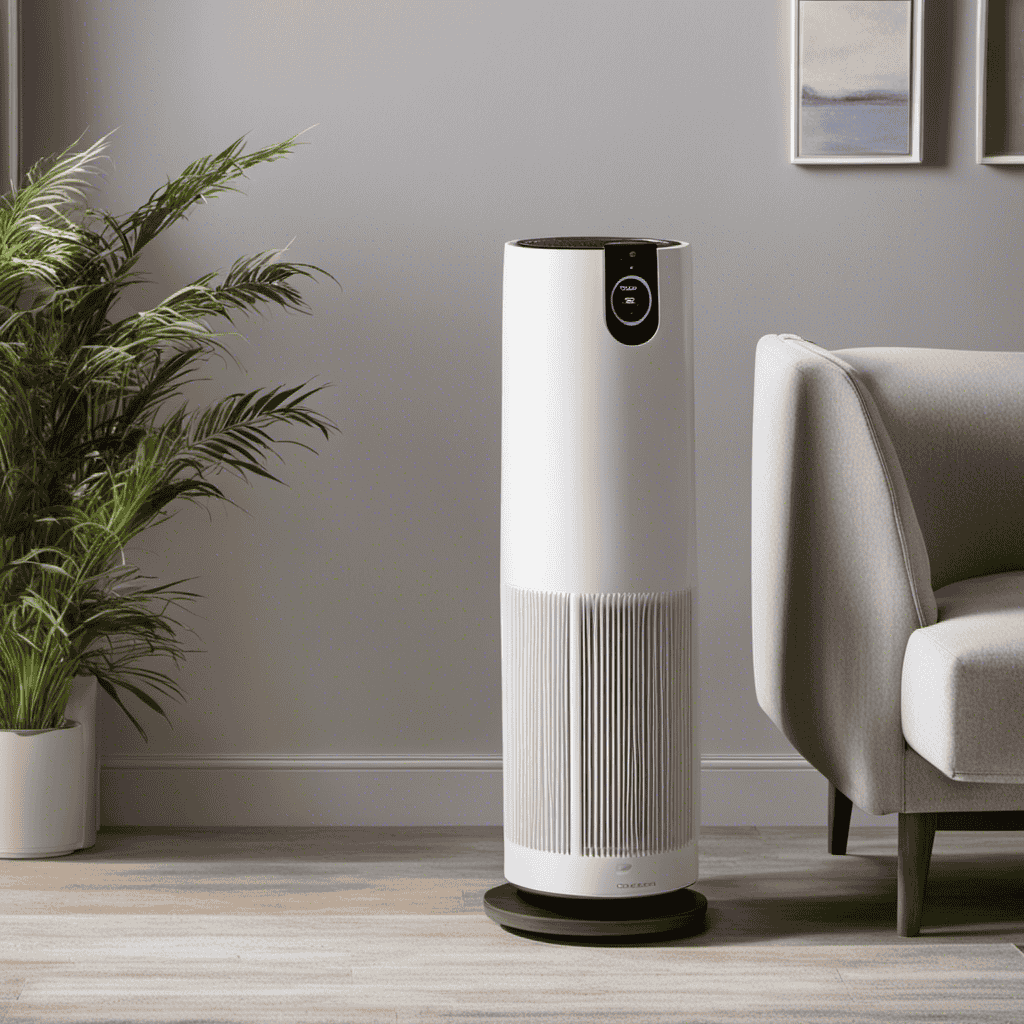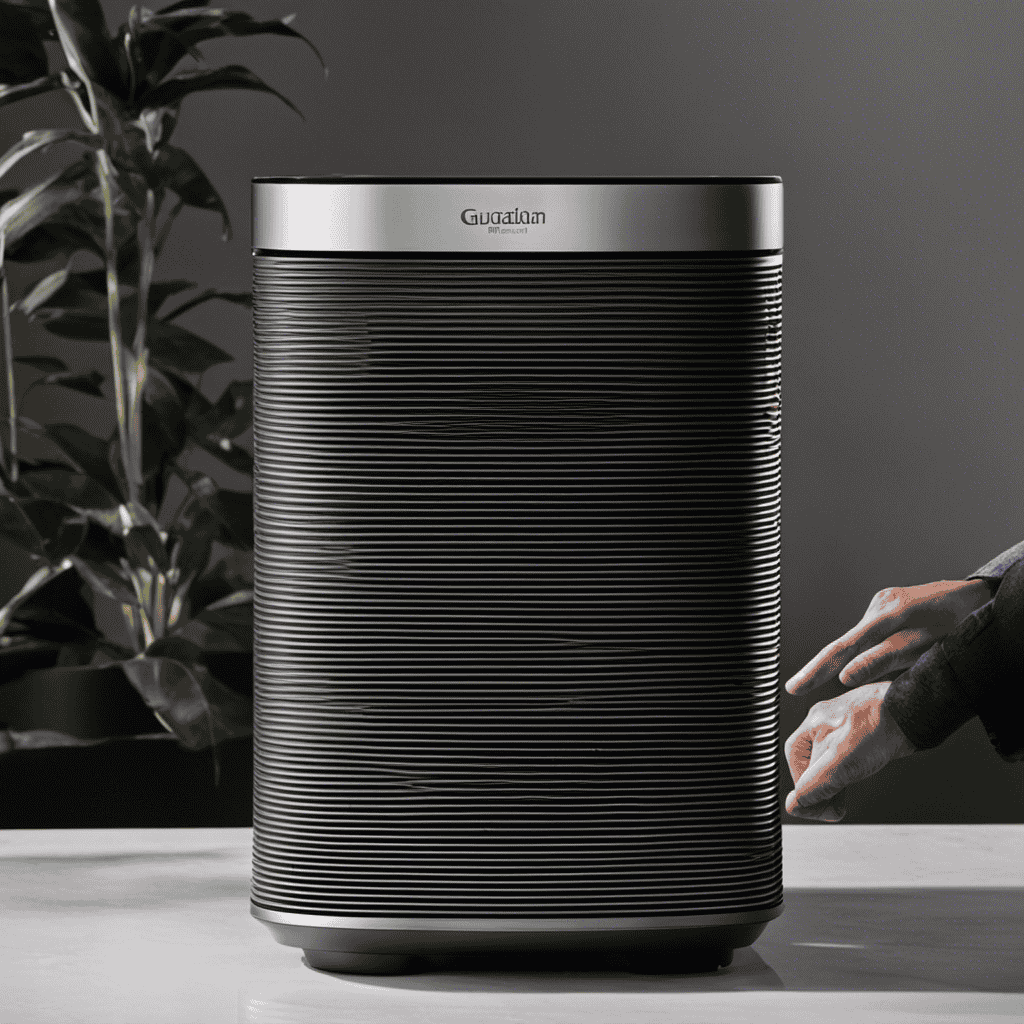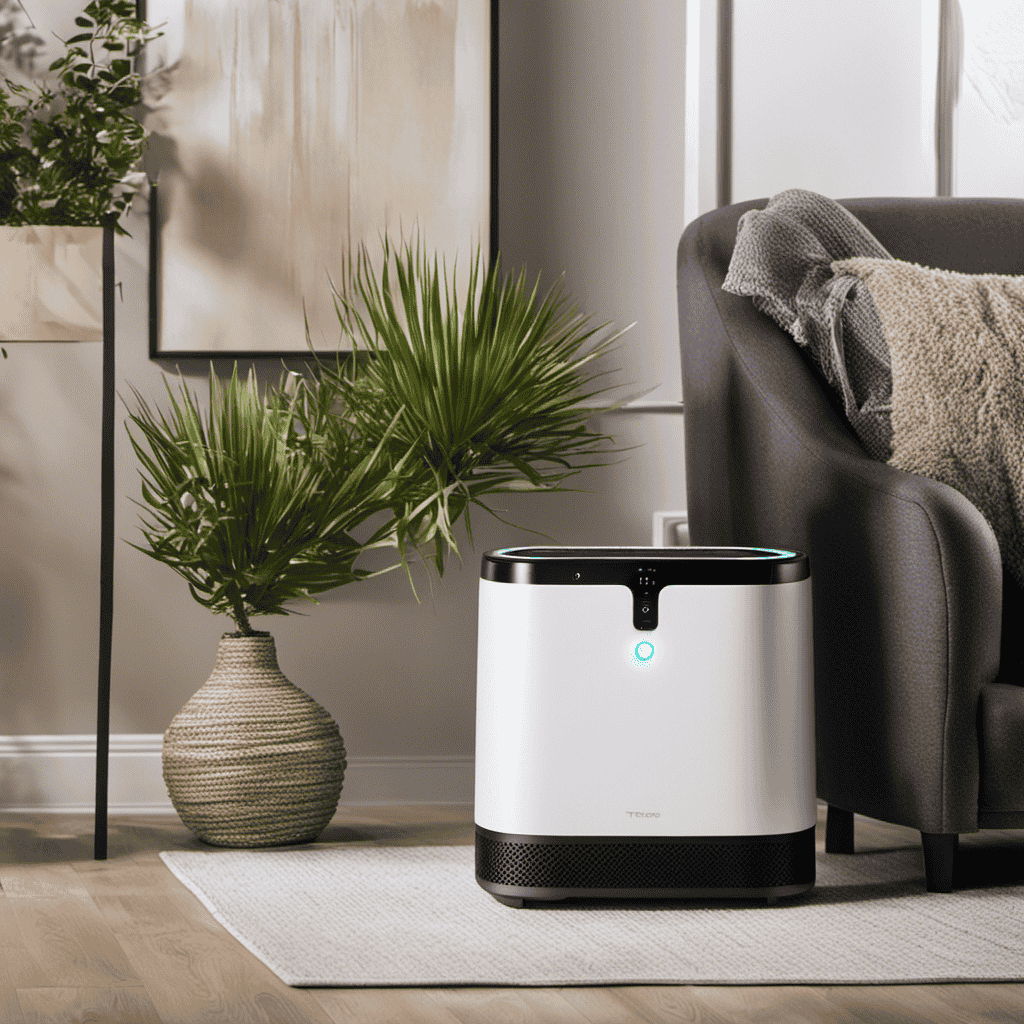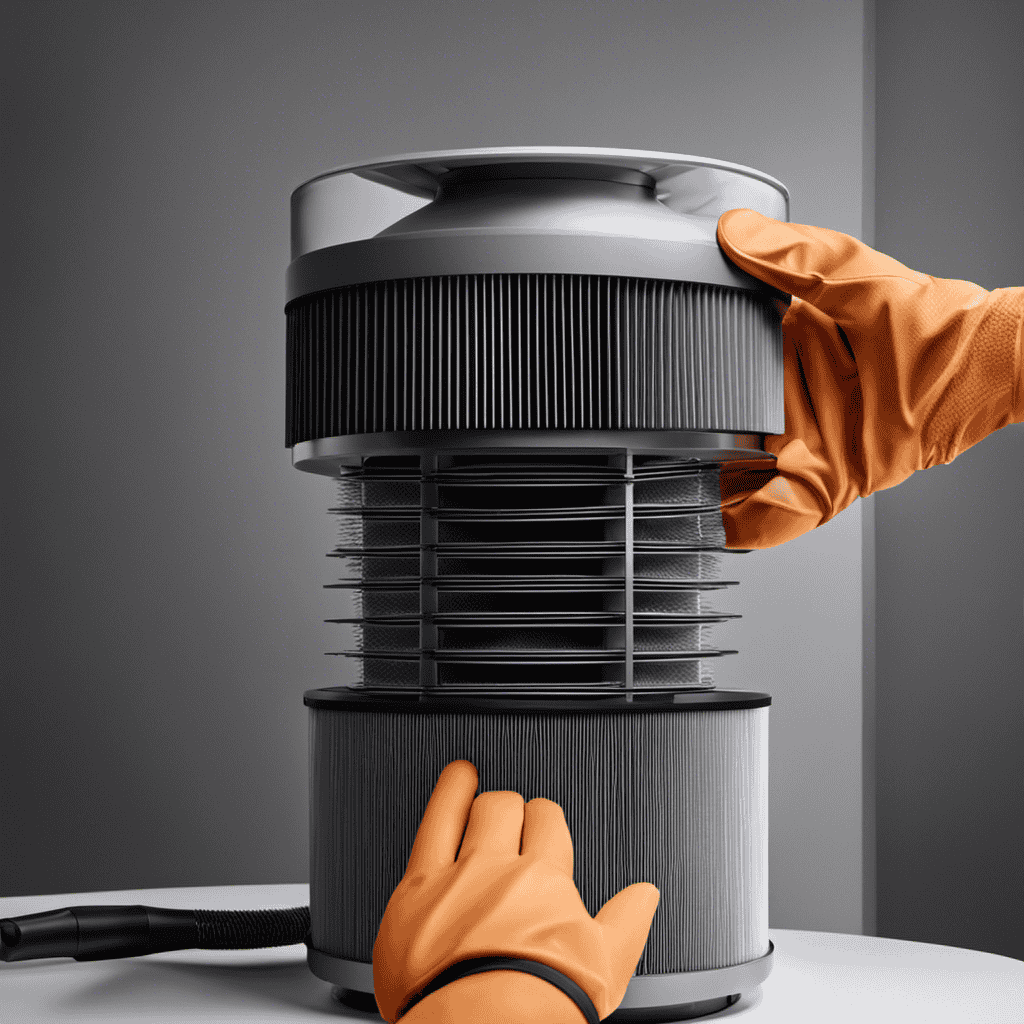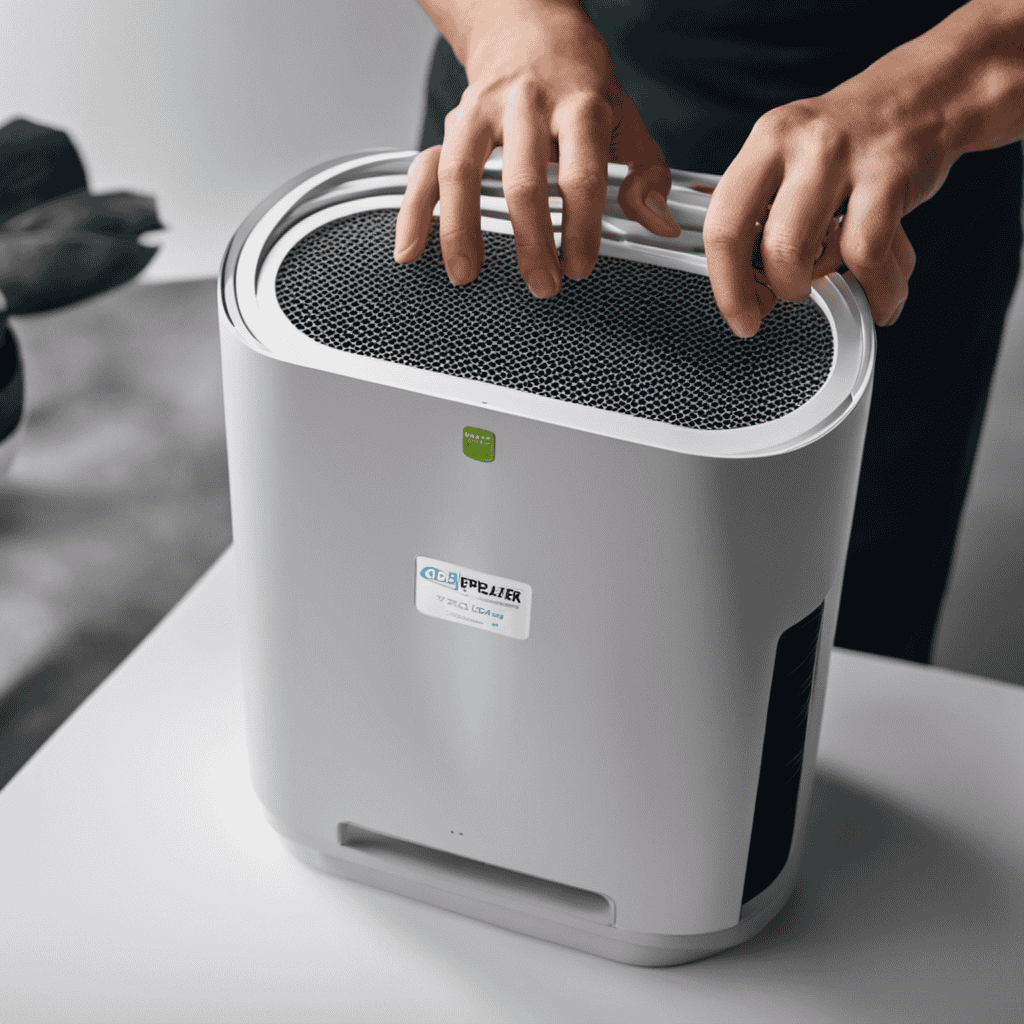While inhaling the musty air in my house, I pondered ways to enhance its quality. It was then that I stumbled upon the wonder of filterless air purifiers. These cutting-edge gadgets redefine the concept of clean air by eliminating impurities using state-of-the-art technology.
In this article, I will delve into the inner workings of filterless air purifiers, exploring the principles behind negative ion generators, electrostatic precipitators, ozone generators, and photocatalytic oxidation.
Let’s embark on a scientific journey to uncover the secrets of cleaner and healthier air.
Key Takeaways
- Filterless air purifiers use negative ions to trap and remove airborne pollutants without traditional filters.
- Negative ion generators release negatively charged ions into the environment, enhancing indoor air quality.
- Ionization process helps reduce allergens, irritants, odors, and harmful substances in the air.
- Filterless air purifiers may have limitations in capturing smaller particles compared to traditional filters.
The Principle Behind Filterless Air Purifiers
The principle behind filterless air purifiers is that they use technology to trap and remove airborne pollutants without the need for traditional filters. These innovative devices employ a unique air purification mechanism that utilizes negative ions.
Negative ions are charged particles that are naturally present in the environment. When released into the air, they attach themselves to positively charged particles, such as dust, pollen, and bacteria. This causes the particles to become heavier and fall out of the air, effectively removing them from the environment.
Filterless air purifiers generate negative ions using various methods, such as corona discharge or ionization. Understanding the working of negative ion generators is crucial to comprehending how filterless air purifiers operate and provide cleaner, healthier air for us to breathe.
Now, let’s delve into the intricacies of these negative ion generators.
Understanding Negative Ion Generators
When it comes to understanding negative ion generators, it’s important to delve into the ionization process and how it works.
By ionizing air molecules, these devices release negatively charged ions into the environment. This can have various health benefits.
In comparison to traditional filters, negative ion generators offer a unique approach to air purification. It may be worth exploring this alternative method.
Ionization Process Explained
To understand how a filterless air purifier works, you’ll want to learn about the ionization process. Ionization is a key component of these purifiers and is responsible for many of their benefits in improving air quality.
When the purifier is turned on, it releases negative ions into the air. These negative ions attach themselves to particles in the air, such as dust, pollen, and pet dander. As a result, the particles become heavier and fall to the ground or attach to surfaces, effectively removing them from the air you breathe.
This process not only helps to reduce allergens and irritants in the air, but it can also eliminate odors and harmful substances. By incorporating ionization, filterless air purifiers provide a simple yet effective way to enhance indoor air quality.
Health Benefits of Ions
If you’re looking to improve your health, incorporating ions into your indoor environment can offer several benefits.
Ionizing technology, commonly used in filterless air purifiers, releases negative ions into the air. These ions attach to harmful particles such as dust, pollen, and pet dander, causing them to become heavy and fall to the ground. This process helps to reduce airborne allergens and irritants, ultimately improving respiratory health.
Additionally, negative ions have been shown to have a positive effect on mood and overall well-being. Studies have found that negative ions can increase serotonin levels in the brain, which can help alleviate symptoms of depression and anxiety.
By incorporating ionizing technology into your indoor environment, you can enjoy the benefits of cleaner air and improved respiratory health.
In the subsequent section, we will compare the effects of ionizing technology with traditional filters to help you make an informed decision for your air purification needs.
Comparison With Traditional Filters
Using a traditional filter for air purification can be an effective alternative to ionizing technology. When comparing traditional air filters to filterless air purifiers, several factors should be considered to determine their cost-effectiveness.
-
Initial Cost: Traditional air filters typically have a lower upfront cost compared to filterless air purifiers, which may require a higher investment initially.
-
Maintenance: Traditional filters need regular replacement, while filterless air purifiers may require less maintenance, resulting in long-term cost savings.
-
Effectiveness: Traditional filters are known for their high efficiency in removing particles from the air, while filterless air purifiers may have limitations in capturing smaller particles.
Electrostatic Precipitators: A Filterless Purification Method
Electrostatic precipitators are an effective method of purifying the air by utilizing the electrostatic attraction mechanism. This mechanism allows the precipitator to efficiently remove pollutants from the air, including dust, smoke, and other particles.
However, it is important to note that regular maintenance and cleaning of the precipitator is crucial for its optimal performance and longevity.
Electrostatic Attraction Mechanism
You can understand how a filterless air purifier works by learning about the way it uses the electrostatic attraction mechanism. This mechanism relies on the principle of electrostatic charge to capture particles from the air. Here’s how it works:
-
Ionization: The air purifier releases ions into the air, which carry a positive or negative charge. These ions attach themselves to the airborne particles, giving them an electrical charge.
-
Attraction: The charged particles are then drawn towards a collection plate with an opposite charge. This electrostatic attraction pulls the particles out of the air and onto the plate.
-
Cleaning: Over time, the particles accumulate on the collection plate, forming a layer of dirt and dust. To maintain the purifier’s efficiency, this plate needs to be cleaned regularly, either by wiping it or using a cleaning mechanism.
Efficient Removal of Pollutants
The efficient removal of pollutants is crucial for maintaining cleaner and healthier indoor environments. With the advancement of technology, various removal techniques have been developed to tackle the challenge of indoor air pollution.
One such technique is the use of filterless air purifiers, which employ advanced technology to effectively eliminate harmful particles from the air. These purifiers utilize a combination of electrostatic attraction and ionization to capture and remove pollutants. The electrostatic attraction mechanism causes the particles to become charged, allowing them to be attracted to oppositely charged plates or surfaces within the purifier. This method ensures that even the smallest particles, such as allergens and pollutants, are efficiently removed from the air.
Transitioning into the subsequent section about maintenance and cleaning, it is important to understand how to properly maintain and clean filterless air purifiers to ensure their optimum performance.
Maintenance and Cleaning
Maintaining and cleaning filterless air purifiers is essential for keeping them in optimal condition and ensuring their effectiveness in removing pollutants from the air. As a user of a filterless air purifier, I have learned some maintenance techniques and common cleaning mistakes to avoid.
Here are three important things to keep in mind:
-
Regular dusting: Dust accumulation on the surface of the purifier can reduce its efficiency. It is important to regularly dust the exterior and interior components to maintain optimal airflow.
-
Cleaning the ionizer: Many filterless air purifiers use ionizers to remove pollutants. Cleaning the ionizer plates or wires is crucial to prevent the build-up of dirt and debris, which can hinder its performance.
-
Avoiding harsh chemicals: When cleaning the purifier, it is important to avoid using harsh chemicals or abrasive materials. These can damage the delicate components of the purifier and reduce its effectiveness.
Ozone Generators: How Do They Purify the Air
Ozone generators use high-voltage electrical currents to purify the air. These devices work by converting oxygen molecules (O2) into ozone (O3). The high-voltage electrical current splits the oxygen molecules, creating individual oxygen atoms. These atoms then collide with other oxygen molecules, forming ozone.
Ozone is an unstable molecule that readily reacts with pollutants, neutralizing them and purifying the air. However, it is important to note that ozone generators can also produce excess ozone, which can be harmful to humans and animals when inhaled in high concentrations. Therefore, it is crucial to use ozone generators with caution and ensure proper ventilation in the area.
Additionally, regular maintenance and monitoring of ozone levels are necessary to ensure ozone safety.
Photocatalytic Oxidation: A Filterless Approach to Air Cleaning
Photocatalytic oxidation is an innovative method that uses a catalyst to purify the air without the need for filters. This process involves a photocatalytic reaction, where a catalyst, typically titanium dioxide, is activated by ultraviolet (UV) light. The activated catalyst then interacts with airborne pollutants, such as volatile organic compounds (VOCs) and bacteria, breaking them down into harmless byproducts.
-
Catalyst Activation: When UV light strikes the catalyst, it triggers a series of chemical reactions, leading to the formation of highly reactive species known as reactive oxygen species (ROS).
-
Pollutant Breakdown: The ROS produced by the catalyst react with the pollutants present in the air, initiating an oxidation process. This results in the conversion of harmful substances into less harmful or even inert compounds.
-
Oxidation Kinetics: The rate at which the pollutants are oxidized depends on various factors, including the concentration of pollutants, catalyst surface area, and intensity of UV light. Understanding the oxidation kinetics helps optimize the design and efficiency of photocatalytic air purifiers.
The Pros and Cons of Filterless Air Purifiers
One of the advantages of filterless air purifiers is that they require less maintenance compared to traditional air purifiers. This is because filterless air purifiers do not rely on filters to clean the air. Instead, they use advanced technologies such as photocatalytic oxidation or electrostatic precipitation to remove pollutants from the air. This means that there are no filters to clean or replace, saving both time and money.
However, it is important to consider the pros and cons of filterless air purifiers. While they are effective at removing certain pollutants, they may not be as effective as traditional purifiers when it comes to capturing smaller particles. Additionally, filterless air purifiers may produce small amounts of ozone, which can be harmful to people with respiratory conditions.
It is important to weigh the effectiveness and limitations of filterless air purifiers before making a decision.
Frequently Asked Questions
How Long Does a Filterless Air Purifier Typically Last Before Needing to Be Replaced?
A filterless air purifier typically lasts for a few years before needing replacement. The lifespan depends on usage and maintenance. The benefits of filterless air purifiers include cost savings and the convenience of not having to regularly replace filters.
Are Filterless Air Purifiers Effective at Removing Allergens From the Air?
Filterless air purifiers are effective at removing allergens from the air. They have several advantages, such as reducing the need for filter replacements and eliminating the possibility of filter clogging.
Can Filterless Air Purifiers Eliminate Odors From the Environment?
Yes, filterless air purifiers can eliminate odors from the environment. They use advanced technology to target bacteria and pet dander, effectively removing them from the air. It’s amazing how they can make any space smell fresh and clean.
Do Filterless Air Purifiers Produce Any Harmful Byproducts or Emissions?
I am discussing whether filterless air purifiers produce any harmful byproducts or emissions. It is important to understand the potential risks associated with these devices and their impact on air quality.
Are Filterless Air Purifiers Suitable for People With Respiratory Conditions or Sensitivities?
Filterless air purifiers are suitable for people with respiratory conditions or sensitivities. They effectively remove pet dander and allergens from small spaces without emitting harmful byproducts or emissions, making them a great choice for those with sensitivities.
Conclusion
In conclusion, filterless air purifiers offer a promising alternative to traditional filtration methods. By harnessing the power of negative ions, electrostatic precipitators, ozone generators, and photocatalytic oxidation, these purifiers effectively remove harmful particles from the air.
While they may not be suitable for all situations, they provide a unique and efficient approach to air cleaning. Like a ray of sunlight piercing through a stormy sky, filterless air purifiers bring freshness and purity to our indoor environments.
Their innovative technology holds great potential for improving air quality and enhancing our well-being.
